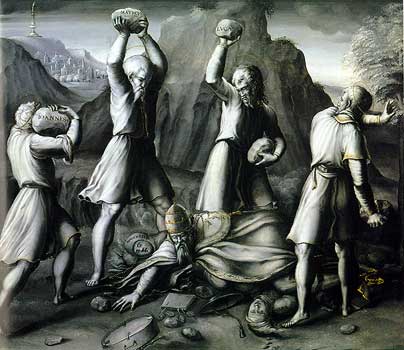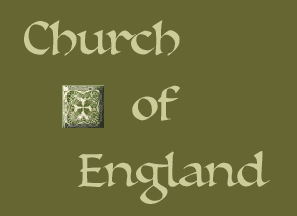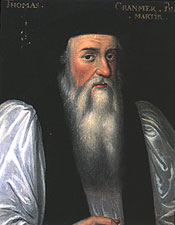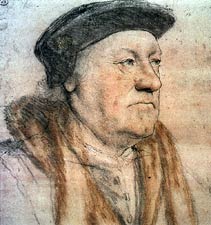|
|
|
|
|
|
|
|
|
|
|
|
|
|
|
|
|
|
|
|
|
|
|
|
|
|
|
|
|
|
|
|
|
|
|
|
|
|
|
|
 |
|
|
|
|
|
|
|
|
|
|
|
|
|
|
|
|
|
|
|
|
|
|
|
 |
|
|
|
|
|
|
|
|
|
|
|
|
|
 |
|
|
|
|
|
|
|
|
|
|
|
Allegory
of the four Evangelists stoning the Pope, painted for Henry VIII by Girolamo
da Treviso c. 1542. The overturned candle under the cauldron in the foreground
stands for the extinguishing of false doctrine. |
|
|
|
|
|
|
|
|
|
|
|
|
|
|
|
|
|
|
|
|
|
|
In
1534 Henry VIII established the Act of Supremacy
and declared himself the "Supreme Head of the Church of England," officially
inciting the English Reformation and unleashing a wave of religious intolerance
and destruction that would not be stemmed until well into the next century.
The single most determining event of the Henrician Reformation was the establishment
of royal supremacy over the Church of England, causing an irrevocable break
with the Roman papacy. The Reformation reversed those Medieval victories of
the church over the monarchy by using the word of God as a basis for obedience
to king and not pope. For the first time in history a king had declared himself
independent of the papacy. Previously, papal authority had acted first by excommunicating
a secular ruler but in this instance Henry VIII had thrown off the pope, even
going so far as to erase his name from service books. Henry's ideal was non-papal
Catholicism, but "to all men alike the state was their real religion and the
King their great High Priest." |
|
|
|
|
|
|
|
|
|
|
|
|
The Reformation
attempted to reshape English society on the basis of the word of God in order
to promote a uniform and literate religious culture in place of the oral and
visual culture of the past. The centerpiece of this effort was the dispersion
of an officially sanctioned English translation of the Bible
which, along with his royal supremacy was Henry's most enduring contribution
to English religious history. In 1538 it was mandated that every church must
contain a bible that be read in English to its parishioners. The protracted
influence of the vernacular Bible lay in its ability to be read and comprehended
by any literate individual and offered the layperson an interpretive immediacy
that its Latin counterpart never could.The wide circulation that the scriptures
now enjoyed contributed to the weakening of the priesthood and further dispelled
the need for narrative images as a means of educating an illiterate public.
The unity of the church was slowly eroded as the explication of the laws of
God were no longer within the sole realm of the clergy. Each individual now
had the ability to discover personal truths hidden within the scriptures. |
|
|
|
|
|
|
|
|
|
|
|
|
|
|
|
|
|
|
|
|
|
|
|
|
|
|
|
|
|
|
 |
|
|
|
|
|
|
|
|
|
|
Detail
from the title page of Cranmer's Great Bible, showing Henry VIII
distributing the Book to the clergy. |
|
|
|
|
|
|
|
|
|
|
|
|
|
|
 |
|
|
|
|
|
|
|
|
|
|
|
|
|
|
|
|
|
|
|
 |
|
|
|
|
|
|
|
|
|
|
|
|
|
|
|
|
|
|
|
|
|
|
|
|
|
|
|
|
|
|
|
|
|
|
|
|
With
Thomas Cranmer as Archbishop of Canterbury and Thomas Cromwell as Henry VIII's
Vicar-general, a new religious culture, strongly tainted with Protestantism
and its rejection of imagery was instituted. The Dissolution
of the Catholic Monasteries began with little opposition in 1536 and continued
throughout 1539, while the year 1538 instituted the beginning of the destruction
of relics and shrines. Cromwell had ambitious plans
for the new Church of England and they included a thorough revision of canonical
laws because papal domination was considered incompatible with royal supremacy.
Cromwell's second injunction of 1538 intensified the message of iconoclasm and
launched the official campaign against imagery. He wrote: |
|
|
|
|
|
|
|
|
|
|
|
|
Thomas
Cranmer, Archbishop of Canterbury |
|
|
|
|
|
|
|
|
|
|
|
|
|
|
|
|
|
|
|
|
|
|
|
|
|
|
|
|
|
|
"Item,
that such images as ye know in any of your cures to be so abused with pilgrimages
or offerings of anything made thereunto, ye shall for avoiding of that most
detestable offence of idolatry, forthwith take down and deley (destroy); and
shall suffer from henceforth no candles, tapers, or images of wax to be set
afore any image or picture, but only the light that commonly goeth across the
church by the rood loft, the light before the sacrament of the altar, and the
light about the sepulchre; which for the adorning of the church and the divine
service, ye shall suffer to remain still, admonishing your parishioners that
images serve for no other purpose but as to be books of unlearned men that can
no letters, whereby they might be otherwise admonished of the lives and conversation
of them that the said images do represent; which images if they abuse for any
other intent than for such remembrances, they commit idolatry in the same, to
the great danger of their souls. And therefore the King's Highness, graciously
tendering the weal of his subjects' souls hath in part already, and more will
hereafter, travail for the abolishing of such images as might be occasion of
so great an offence to God, and so great danger to the souls of his loving subjects." |
|
|
|
|
|
|
|
|
|
|
|
|
|
|
|
|
|
|
|
|
|
|
|
Thomas
Cromwell,
Vicar-general to Henry VIII |
|
|
|
|
|
|
|
|
|
 |
|
|
|
|
|
|
|
Cromwell's
injunctions of 1538 was the first charge in what was to be a prolonged campaign
by the Church of England against the use of religious imagery as well as their
mere existence. This campaign of iconoclasm intensified
under Edward VI, was reversed under Mary,
but reinstated under Elizabeth and reached its
final denouement during the Civil War of the 17th century, when Parliamentary
armies sought to destroy "images, altars or tables turned altarwise, crucifixes,
superstitious pictures, ornaments and relics of idolatry" from all churches
in order "to throw to the moals and the bats every rag that hath not Gods stamp
and name upon it to complete that left incomplete in the first Reformation."
Not until the restoration of Charles II did the effects of the Henrician Reformation
finally come to subside. By this time, an entire way of life had come to an
end. The Medieval foundations of the church had all but been destroyed, while
its institutional role had been severely curtailed. The public could no longer
looked to the clergy or the worship of saints and holy relics as intercessors
for their salvation or hope that highly ritualistic ceremonies would grant their
wishes. While the use of images ceased to play a significant part, the importance
of the word took on a whole new meaning as a visual culture, entrenched in the
traditions of the Middle Ages gave way to a society that was better able to
comprehend the word of God. While Henry VIII vernacular Bible became a
formidable weapon in the enforcement of the English Reformation, it promulgated
literacy and left a literary legacy that changed the face of the English church. |
|
|
|
|
|
|
|
|
|
|
|
|
|
|
|
|
|
|
|
|
|
 |
|
|
|
|
|
|
|
|
|
|
|
|
|
|
|
|
|
|
|
|
|
|
|
|
|
|
|
|
|
|
 |
|
|
|
|
|
|
|
|
|
|
|
|
|
 |
|
|
|
|
|
|
|
|
|
|
|
|
|
|
|
|
|
|
 |
 |
 |
 |
 |
 |
 |
 |
 |
 |
 |
 |
 |
 |
 |
 |
 |
 |
 |
 |
 |
 |
 |
 |
 |
 |
 |
 |
 |
 |
 |
 |
 |
 |
 |
 |
 |




